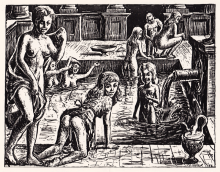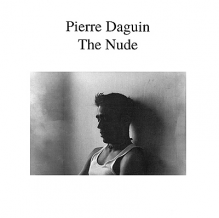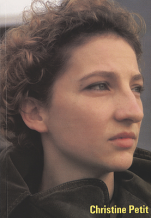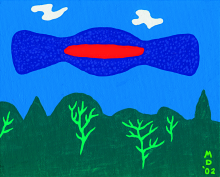| Revista Umělec 2002/4 >> Relational aesthetics (part 3) | Lista de todas las ediciones | ||||||||||||
|
|||||||||||||
Relational aesthetics (part 3)Revista Umělec 2002/401.04.2002 Nicolas Bourriaud | Teoría | en cs |
|||||||||||||
|
Space-time exchange factors
Artworks and exchanges Because art is made of the same material as the social exchanges, it has a special place in the collective production process. A work of art has a quality that sets it apart from other things produced by human activities. This quality is its (relative) social transparency, if a work of art is successful, it will invariably set its sights beyond its mere presence in space: it will be open to dialogue, discussion, and that form of inter-human negotiation that Marcel Duchamp called “the coefficient of art,” which is a temporal process, being played out here and now. This negotiation is undertaken in a spirit of “transparency” which hallmarks it as a product of human labour. The work of art actually shows (or suggests) not only its manufacturing and production process, its position within the set of exchanges, and the place, or function, it allocates to the beholder, but also the creative behaviour of the artist (otherwise put, the sequence of postures and gestures which make up his/her work, and which each individual work passes on like a sample or marker). So every canvas produced by Jackson Pollock so closely links the flow of paint to an artist’s behaviour, that the latter seems to be the image of the former, like its “necessary product,” as Hubert Damisch has written. At the beginning of art we find the behaviour adopted by the artist, that set of moods and acts whereby the work acquires its relevance in the present. The “transparency” of the artwork comes about from the fact that the gestures forming and informing it are freely chosen or invented, and are part of its subject. For example, over and above the popular icon represented by the image of Marilyn Monroe, the sense of Andy Warhol’s Marilyn stems from the industrial production process adopted by the artist, governed by an altogether mechanical indifference to the subjects selected by him. This “transparency” of artistic work contrasts, need it be said, with the sacred, and with those ideologies which seek in art the means of giving the religious a new look. This relative transparency, which is an a priori form of artistic exchange, seems intolerable to the bigot. We know that, once introduced into the exchange circuit, any kind of production takes on a social form which no longer has anything to do with its original usefulness. It acquires an exchange value that partly covers and shrouds its primary “nature.” The fact is that a work of art has no a priori useful function — not that it is socially useless, but because it is available and flexible, and has an “infinite tendency.” In other words, it is devoted, right away, to the world of exchange and communication, the world of “commerce,” in both meanings of the term. What all goods have in common is the fact that they have a value, that is, a common substance that permits their exchange. This substance, according to Marx, is the “amount of abstract labour” used to produce this item. It is represented by a sum of money, which is the “abstract general equivalent” of all goods between them. It has been said of art, and Marx was the first, that it represents the “absolute merchandise,” because it is the actual image of the value. But what exactly are we talking about? About the art object, not about artistic practice, about the work as it is assumed by the general economy, and not its own economy. Art represents a barter activity that cannot be regulated by any currency, or any “common substance.” It is the division of meaning in the wild state — an exchange whose form is defined by that of the object itself, before being so defined by definitions foreign to it. The artist’s practice, and his behaviour as producer, determines the relationship that will be struck up with his work. In other words, what he produces, first and foremost, is relations between people and the world, by way of aesthetic objects. The subject of the artwork Every artist whose work stems from relational aesthetics has a world of forms, a set of problems and a trajectory which are all his own. They are not connected together by any style, theme or iconography. What they do share together is much more decisive, to wit, the fact of operating within one and the same practical and theoretical horizon: the sphere of inter-human relations. Their works involve methods of social exchanges, interactivity with the viewer within the aesthetic experience being offered to him/her, and the various communication processes, in their tangible dimension as tools serving to link individuals and human groups together. So they are all working within what we might call the relational sphere, which is to today’s art what mass production was to Pop Art and Minimal Art. They all root their artistic praxis within a proximity which relativizes the place of visuality in the exhibition protocol, without belittling it. The artwork of the 1990s turns the beholder into a neighbour, a direct interlocutor. It is precisely the attitude of this generation toward communications that makes it possible to define it in relation to previous generations. Most artists emerging in the 1980s, from Richard Prince to Jeff Koons by way of Jenny Holzer, developed the visual aspect of the media, while their successors show a preference for contact and tactility. They prefer immediacy in their visual writing. This phenomenon has a sociological explanation, given that the decade that has just gone by, marked as it was by the recession, turned out to be not very propitious to spectacular and showy undertakings. There are also purely aesthetic reasons for this: the “back to” pendulum came to a halt in the 1980s on movements from the 1960s, and mainly Pop Art, whose visual effectiveness underpins most of the forms proposed by simulationism. For better or for worse, our era is identified, right clown to its crisis “ambience,” with the “poor” and experimental art of the 1970s. This albeit superficial voguish effect made it possible to re-view the works of artists like Gordon Matta-Clark and Robert Smithson, while the success of Mike Kelley recently encouraged a rereading of Californian “Junk Art,” from Paul Thek to Tetsumi Kudo. Fashion also creates aesthetic microclimates, the effects of which have repercussions even on our reading of recent history. Otherwise put, the sieve organises the mesh of its net in different ways, and “lets through” other types of works — which, in return, influence the present. This said, we find ourselves, with relational artists, in the presence of a group of people who, for the first time since the appearance of Conceptual Art in the mid sixties, in no way draw sustenance from any re-interpretation of this or that past aesthetic movement. Relational art is not the revival of any movement, nor is it the comeback of any style. It arises from an observation of the present and from a line of thinking about the fate of artistic activity. Its basic claim — the sphere of human relations as artwork venue — has no prior example in art history, even if it appears, after the fact, as the obvious backdrop of all aesthetic praxis, and as a modernist theme to cap all modernist themes. Suffice it merely to re read the lecture given by Marcel Duchamp in 1954, titled “The Creative Process,” to become quite sure that interactivity is anything but a new idea... Novelty is elsewhere. It resides in the fact that this generation of artists considers inter-subjectivity and interaction neither as fashionable theoretical gadgets, not as additives (alibis) of a traditional artistic practice. It takes them as a point of departure and as an outcome, in brief, as the main informers of their activity. The space where their works are displayed is altogether the space of interaction the space of openness that ushers in all dialogue (Georges Bataille would have written: “rift” [“déchirure”]). What they produce are relational space-time elements, inter-human experiences trying to rid themselves of the straitjacket of the ideology of mass communications, in a way, of the places where alternative forms of sociability, critical models and moments of constructed conviviality are worked out. It is nevertheless quite clear that the age of the New, Man, future- oriented manifestos, and calls for a better world all ready to be walked into and lived in is well and truly over. These days, utopia is being lived on a subjective, everyday basis, in the real time of concrete and intentionally fragmentary experiments. The artwork is presented as a social interstice within which these experiments and these new “life possibilities” appear to be possible. It seems more pressing to invent possible relations with our neighbours in the present than to bet on happier tomorrows. That is all, but it is quite something. And in any event it represents a much-awaited alternative to the depressive, authoritarian and reactionary thinking which, in France at least, passes for art theory in the form of “common sense” rediscovered. Modernity, however, is not dead, if we acknowledge as modern a soft spot for aesthetic experience and adventurous thinking, as contrasted with the cautious forms of conventionality being defended by our freelance philosophers, the neo-traditionalists (“Beauty” according to the priceless Dave Hickey) and those backward-looking militant such as Jean Clair. Whatever these fundamentalists clinging to yesterday’s good taste may say and think, present-day art is roundly taking on and taking up the legacy of the 20th century avant-gardes, while at the same time challenging their dogmatism and their teleological doctrines. Rest assured that much pondering went into this last sentence: it is simply time to write it down. For modernism was steeped in an “imaginary of contrasts,” to borrow Gilbert Durand’s term, which proceeded by way of separations and contrasts, readily disqualifying the past in favour of the future. It was based on conflict, whereas the imaginary of our day and age is concerned with negotiations, bonds and co-existences. These days we are no longer trying to advance by means of conflictual clashes, by way of the invention of new assemblages, possible relations between distinct units, and alliances struck up between different partners. Aesthetic contracts, like social contracts, are abided by for what they are. Nobody nowadays has ideas about ushering in the golden age on Earth, and we are readily prepared just to create various forms of modus vivendi permitting fairer social relations, more compact ways of living, and many different combinations of fertile existence. Art, likewise, is no longer seeking to represent utopias: rather; it is attempting to construct concrete spaces. Space-time factors in 1990s’ art These “relational” procedures (invitations, casting sessions, meetings, convivial and user-friendly areas, appointments, etc.) are merely a repertory of common forms, vehicles through which particular lines of thought and personal relationships with the world are developed. The subsequent form that each artist gives to this relational production is not unalterable, either. These artists perceive their work from a threefold viewpoint, at once aesthetic (how is it to be “translated” in material terms?), historical (how is to be incorporated in a set of artistic references?) and social (how is to find a coherent position with regard to the current state of production and social relations?). These activities evidently acquire their formal and theoretical marks in Conceptual Art, in Fluxus and in Minimal Art, but they simply use these like a vocabulary, a lexical basis. Jasper Johns, Robert Rausch-enberg and the New Realists all relied on tile readymade to develop both their rhetoric about the object, and their sociological discourse. When relational art makes reference to conceptual and Fluxus-inspired situations and methods, or to Gordon Matta-Clark, Robert Smith-son and Dan Graham, it is to convey lines of thought which have nothing to do with their own thinking. The real question is more likely this: what are the right exhibition methods in relation to the cultural context and in relation to the history of art as it is being currently updated? Video, for example, is nowadays becoming a predominant medium. But if Peter Land, Gillian Wearing and Henry Bond, to name just three artists, have a preference for video recording, they are still not “video artists.” This medium merely turns out to be the one best suited to the formalisation of certain activities and projects. Other artists thus produce a systematic documentation about their work, thereby drawing the lessons of Conceptual Art, but on radically different aesthetic bases. Relational art, which is well removed from the administrative rationality that underpins it (the form of the notarised contract, ubiquitous in the sixties’ art), tends to draw inspiration more from the flexible processes governing ordinary life. We can use the term communications, but here, too, today’s artists are placed at the other extreme, compared with how artists made use of the media in the previous decade. Where these artists tackled the visual form of mass communications and the icons of pop culture. Liam Gillick, Miltos Manetas and Jorge Pardo work on scaled-down models of communicational situations. This can be interpreted as a change in the collective sensibility. Henceforth the group is pitted against the mass, neighbourliness against propaganda, low tech against high tech, and the tactile against the visual. And above all, the everyday now turns out to be a much more fertile terrain than “pop culture” a form that only exists in contrast to “high culture,” through it and for it. To head off tiny polemic about a so-called return to “conceptual” art, let us bear in mind that these works in no way celebrate immateriality. None of these artists has a preference for “performances” or concept, words that no longer mean a whole lot here. In a word, the work process no longer has any supremacy over ways of rendering this work material (unlike Process Art and Conceptual Art, which, for their part, tended to fetishize the mental process to the detriment of the object). In the worlds constructed by these artists, on the contrary, objects are an intrinsic part of the language, with both regarded as vehicles of relations to the other. In a way, an object is every, bit as immaterial as a phone call. And a work that consists in a dinner around a soup is every bit as material as a statue. This arbitrary, division between the gesture and the forms it produces is here called into question, insofar as it is the very image of contemporary alienation: the cannily maintained illusion, even in art institutions, that objects excuse methods and that the end of art justifies the pettiness of the intellectual and ethical means. Objects and institutions, and the use of time and works, are at once the outcome of human relations — for they render social work concrete - and producers of relations — for, conversely, they organise types of sociability and regulate inter-human encounters. Today’s art thus prompts us to envisage the relations between space and time in a different way. Essentially, moreover, it derives its main originality from the way this issue is handled. What, actually, is concretely produced by artists such as Liam Gillick, Dominique Gonzalez-Foerster and Vanessa Beecroft? What, in the final analysis, is the object of their work? To introduce a few comparative factors, we should have to embark upon a history of the use value of art. When a collector purchased a work by Jackson Pollock or Yves Klein, he was buying, over and above its aesthetic interest, a milestone in a history on the move. He became the purchaser of a historical situation. Yesterday, when you bought a Jeff Koons, what was being brought to the fore was the hyper-reality of artistic value. What has one bought when one owns a work by Tiravanija or Douglas Gordon, other than a relationship with the world rendered concrete by an object, which, per se, defines the relations one has towards this relationship: the relationship to a relationship? Notes: 1. Jean-François Lyotard: “The post modern explained to children,” London, Turnaround, 1992 2. Michel de Certeau: Manieres de faire, Editions Idées-Gallimard. 3. Louis Althusser: Ecrits philo-sophiques et politiques, Editions Stock-IMEC, 1995, p. 557. 4. Michel Maffesoli: La contemplation du monde, Editions Grasset, 1993. 5. Hubert Damisch: Fenetre jaune cadmium, Editions du Seuil. 6. Thierry de Duve: Essais datés. Editions de La Différence, 1987. 7. Emmanuel Lévinas: Ethique et infini, Poche-Biblio, p. 93. 8. Serge Daney: Persévérance, Editions P.O.L., 1992, p. 38. 9. Tzvetan Todorov: La Vie commune, Editions du Seuil, 1994. 10. Hubert Damisch, Fenetre jaune cadmium, Editions du Seuil, p. 76. Chapters 1 and 3 from the book Relational Aesthetics by Nicolas Bourriaud, published in English by Press du Réel in 2002. Reprinted here with permission.
01.04.2002
Artículos recomendados
|
|||||||||||||
|
04.02.2020 10:17
Letošní 50. ročník Art Basel přilákal celkem 93 000 návštěvníků a sběratelů z 80 zemí světa. 290 prémiových galerií představilo umělecká díla od počátku 20. století až po současnost. Hlavní sektor přehlídky, tradičně v prvním patře výstavního prostoru, představil 232 předních galerií z celého světa nabízející umění nejvyšší kvality. Veletrh ukázal vzestupný trend prodeje prostřednictvím galerií jak soukromým sbírkám, tak i institucím. Kromě hlavního veletrhu stály za návštěvu i ty přidružené: Volta, Liste a Photo Basel, k tomu doprovodné programy a výstavy v místních institucích, které kvalitou daleko přesahují hranice města tj. Kunsthalle Basel, Kunstmuseum, Tinguely muzeum nebo Fondation Beyeler.
|






























 We Are Rising National Gallery For You! Go to Kyjov by Krásná Lípa no.37.
We Are Rising National Gallery For You! Go to Kyjov by Krásná Lípa no.37.
Comentarios
Actualmente no hay comentariosAgregar nuevo comentario